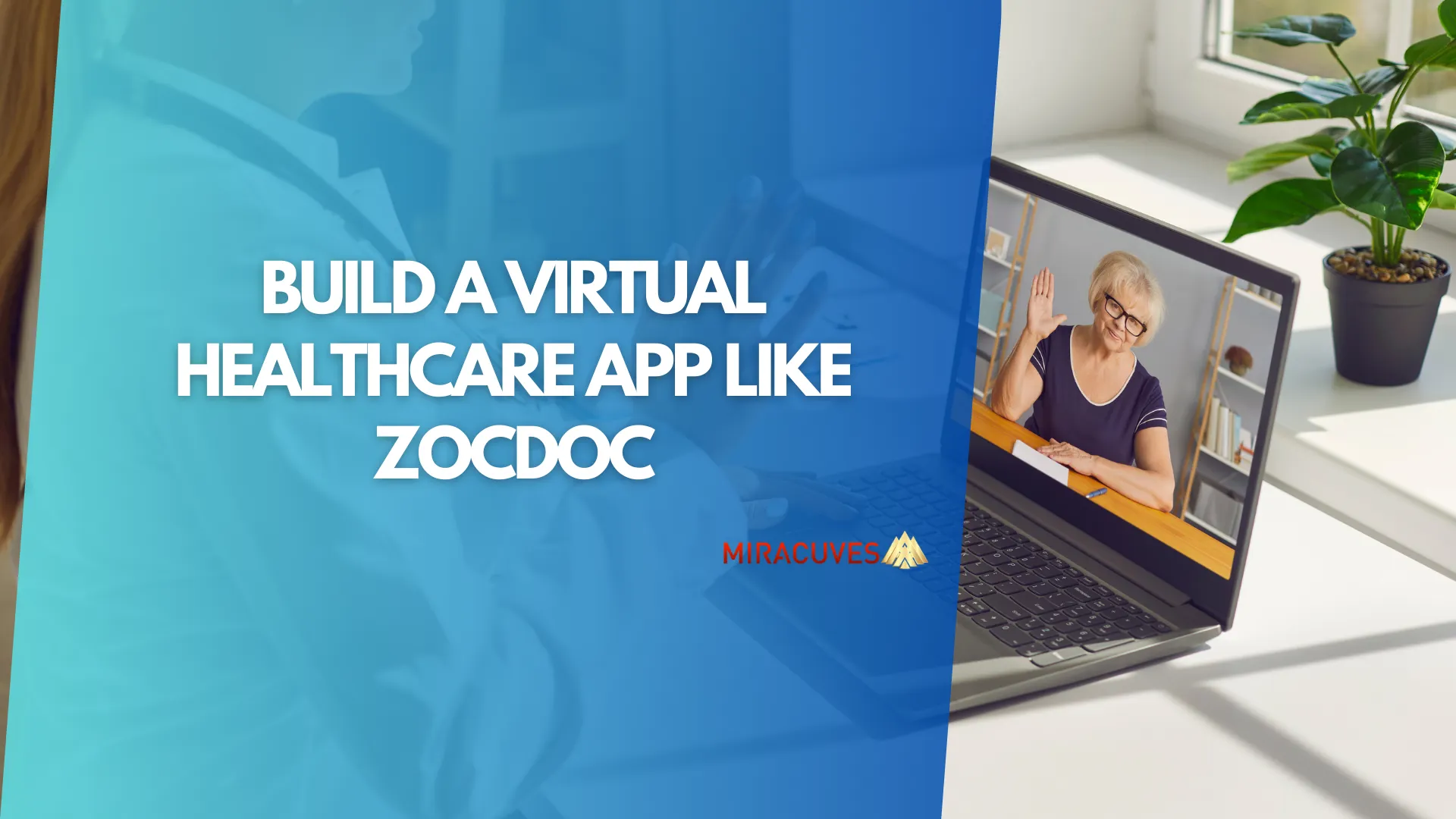In today’s digital age, healthcare is increasingly moving online, with patients preferring the convenience of booking medical appointments from their phones. Virtual healthcare apps have become essential for connecting patients with doctors, streamlining medical scheduling, and offering telemedicine consultations. Zocdoc, a popular player in this space, has set a benchmark by simplifying the appointment process for both patients and healthcare providers.
Aufbau eines virtuelle Gesundheitsversorgung app like Zocdoc offers immense opportunities, allowing businesses to tap into the growing demand for accessible and efficient healthcare services. With a well-designed app, you can deliver real value by reducing wait times, ensuring hassle-free bookings, and even providing virtual consultations. This guide will walk you through everything you need to know—from core features to development timelines and industry trends—so you can build a competitive medical scheduling app.
If you want to develop your app faster and at 10% of the global cost, Miracuves-Lösungen provides ready-made, customizable solutions. Instead of taking months, your app can be ready for launch in just 1 day. Let’s dive deeper into the essentials of building your virtual healthcare platform and explore how this exciting opportunity can benefit both your business and your users.
What is Zocdoc, and What Does It Do?
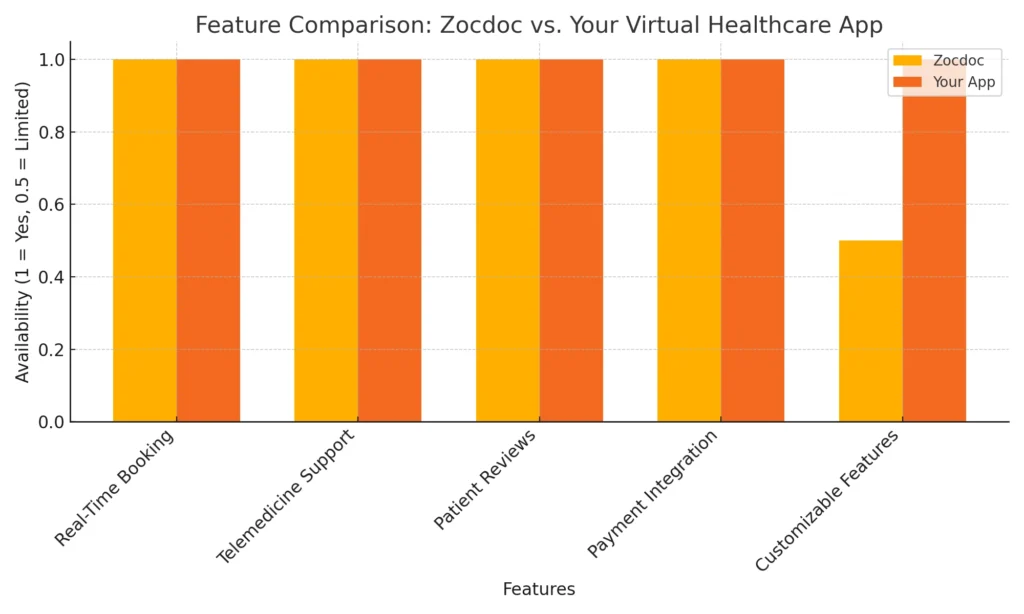
Zocdoc is an online healthcare platform designed to simplify the process of booking medical appointments. Founded in 2007, it connects patients with doctors across various specialties, allowing users to search, schedule, and manage their consultations with ease. Patients can book both virtual telemedicine sessions and in-person appointments through the platform. Zocdoc also provides access to verified patient reviews, helping users make informed decisions when choosing healthcare providers.
The platform offers real-time availability of doctors, ensuring that patients can book their preferred slots without delay. It integrates payment gateways for seamless transactions and offers features like appointment reminders to minimize no-shows. Zocdoc’s business model benefits both patients and providers, helping clinics and hospitals manage appointments more efficiently while expanding their reach to a broader audience.
In essence, Zocdoc bridges the gap between patients and healthcare professionals by providing a benutzerfreundliche Oberfläche for booking and managing consultations. Its success highlights the growing need for virtual healthcare apps that can offer similar or better services to meet modern demands.
Why Should You Build This App?

Building a virtual healthcare app is no longer just an option; it’s a necessity. The global healthcare landscape is evolving rapidly, with more patients opting for online consultations and remote healthcare services. Platforms like Zocdoc have proven that medical scheduling apps can significantly improve access to healthcare by reducing waiting times and providing patients with the flexibility to choose from a variety of doctors.
By developing your own healthcare app, you can tap into this growing demand and provide a better Lösung tailored to your audience’s needs. Whether it’s offering custom features, supporting underserved regions, or focusing on specific specialties, your app has the potential to stand out from the crowd.
Moreover, the healthcare industry is becoming increasingly competitive, and hospitals and clinics now rely heavily on digital tools to manage their patient flow efficiently. An app like this enhances patient satisfaction, optimizes appointment management, and helps healthcare providers focus on delivering quality care.
With Miracuves Solutions, you can build your app in just 1 day and at 10% of the global development cost, giving you a significant advantage over others who take months and incur high expenses. Seize this opportunity to stay ahead in the digital healthcare revolution.
How to Differentiate Your App from Competitors
With established players like Zocdoc dominating the healthcare space, building a competitive app requires more than just replicating existing features. The key lies in differentiation—creating unique value that sets your platform apart from the rest. Here are a few strategies to help your app stand out:
- AI-Driven Doctor Recommendations
- Hebelwirkung künstliche Intelligenz to suggest doctors based on patient history and preferences.
- Personalization ensures patients get matched with the right specialists quickly.
- Specialized Focus on Niche Segments
- Target specific healthcare areas such as mental health counseling or chronic disease management to meet underserved needs.
- This creates a unique space in the market, attracting a dedicated audience.
- Seamless Integration with Wearables and Health Devices
- Sync patient health data from smartwatches and fitness trackers to offer better care recommendations.
- Providers get real-time insights, which enhances the quality of teleconsultations.
- Flexible Pricing and Premium Features
- Offer freemium models: Free consultations with general practitioners and paid access to specialists.
- Introduce subscription plans for unlimited teleconsultations or priority booking options.
- Enhanced User Experience with Gamification
- Use gamified elements like reward points for booking regular health check-ups or completing profiles.
- This encourages frequent use and boosts engagement.
With these strategies, your app can go beyond being just another scheduling platform—it becomes a comprehensive healthcare experience, offering real value to both patients and healthcare providers.
Lesen Sie auch: - Top 10 Ideen für Unternehmensgründungen im Bereich psychische Gesundheit und Beratung
Market Size, Growth, and Revenue Model
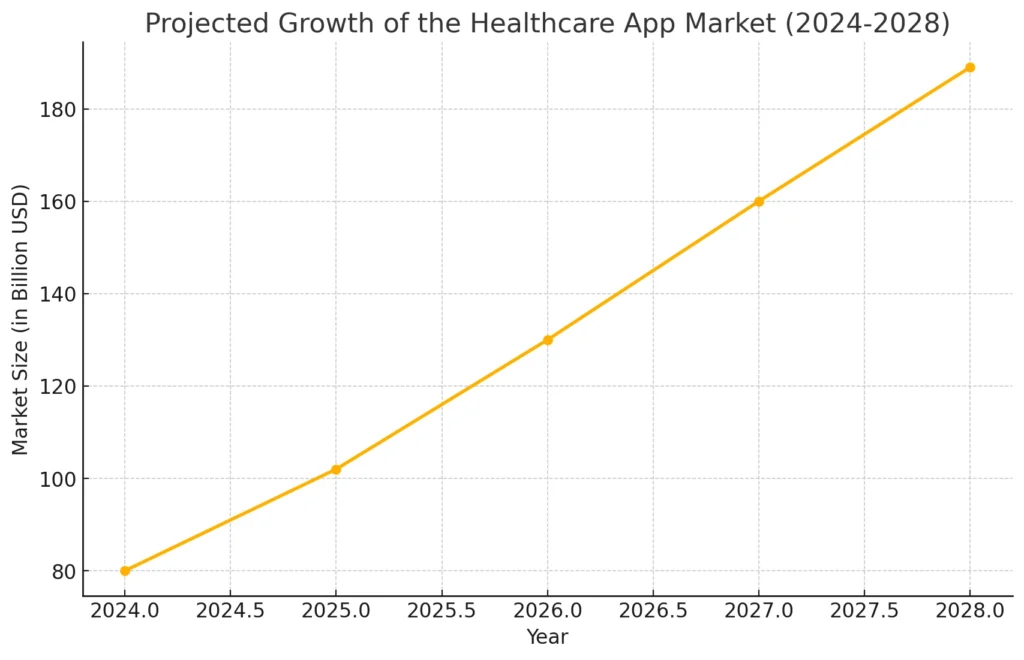
The healthcare app market is experiencing explosive growth, driven by the increasing need for convenient access to healthcare services and the rise of telemedicine. As patients embrace digital platforms for booking appointments and virtual consultations, this industry is set to grow even further in the coming years.
Market Size and Growth Trends
- Der global healthcare app market is projected to reach $189 billion by 2028, growing at a compound annual growth rate (CAGR) of 27.7%.
- Telemedicine platforms, in particular, have surged in popularity, with 65% of users preferring remote consultations over in-person visits.
- Online appointment scheduling alone is expected to generate significant revenue, driven by healthcare providers’ need for efficient patient flow management.
Revenue Models for Virtual Healthcare Apps
Building a sustainable healthcare app requires a well-defined revenue model. Here are the most effective options:
- Abonnements: Patients or providers pay monthly fees for unlimited access to services.
- Commission on Bookings: Charge a percentage fee on every appointment booked via the platform.
- In-App Advertising: Monetize by displaying health-related ads.
- Freemium-Modell: Offer basic services for free and charge for premium features like specialist consultations or video calls.
By leveraging these revenue streams, your app can grow sustainably while offering value-driven healthcare services.
Features of the App
| Besonderheit | Zocdoc | Your App |
|---|---|---|
| Doctor Search and Filters | Ja | Ja |
| Buchung in Echtzeit | Ja | Ja |
| Telemedicine Support | Ja | Ja |
| In-App Payments | Ja | Ja |
| Push-Benachrichtigungen | Ja | Ja |
| KI-gestützte Empfehlungen | NEIN | Ja |
| Health Data Integration | NEIN | Ja |
| Multi-User Accounts | NEIN | Ja |
| Ratings and Feedback | Ja | Ja |
To build a virtual healthcare app like Zocdoc, it’s essential to offer a mix of core and advanced features that enhance user experience, accessibility, and efficiency. These features will not only attract users but also help establish your app as a comprehensive platform for healthcare services.
Kernfunktionen
- Doctor Search and Filters
- Users can search for doctors by specialty, location, or availability.
- Filters allow easy sorting based on ratings, fees, or patient reviews.
- Terminvereinbarung
- Real-time booking with instant confirmation.
- Syncs with users’ calendars to avoid overlapping appointments.
- Telemedicine Support
- Virtual consultations via video or audio calls.
- Enables patients to get prescriptions and follow-up care remotely.
- In-App Payments
- Secure payment gateways for seamless transactions.
- Support for multiple payment options (credit cards, wallets, etc.).
- Push Notifications and Reminders
- Automated reminders for upcoming appointments.
- Notifications for follow-ups and prescription renewals.
Erweiterte Funktionen
- AI-Powered Doctor Recommendations
- Suggests doctors based on patient history and preferences.
- Health Data Integration
- Sync with wearables to track real-time health metrics like heart rate.
- Multi-User Accounts
- Family members can book and manage appointments under one profile.
- Ratings and Feedback System
- Patients can rate doctors and provide reviews to enhance transparency.
These features ensure a smooth and user-friendly experience for both patients and healthcare providers. By implementing these, your app will not only match but surpass the capabilities of competitors.
Technical Requirements
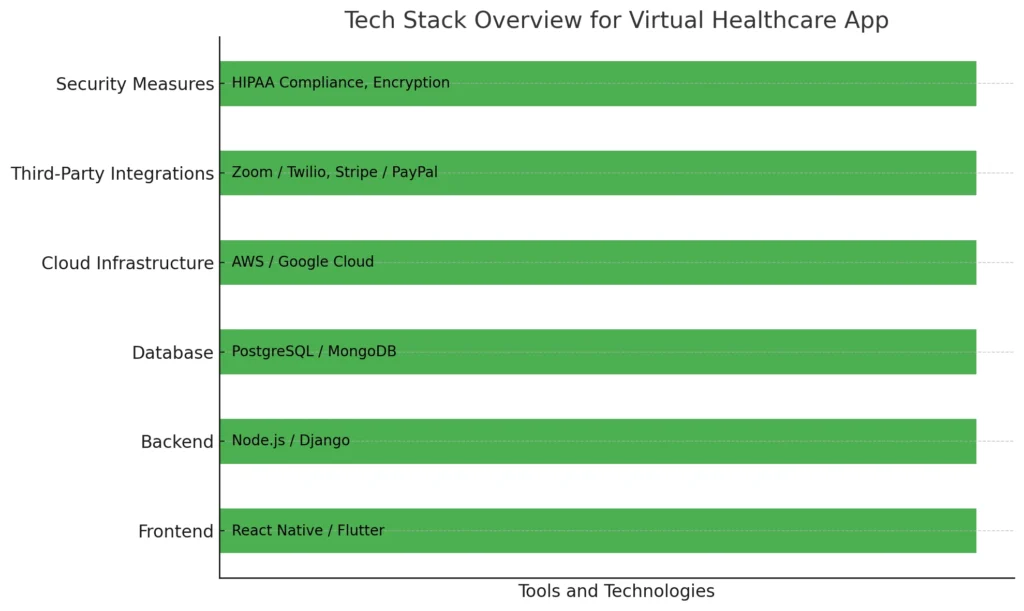
Aufbau eines virtual healthcare app requires a solid technical foundation to ensure smooth performance, secure data handling, and a seamless user experience. Here’s an overview of the essential tech stack and infrastructure needed to develop an app like Zocdoc.
Recommended Tech Stack
- Frontend-Technologien
- Native reagieren oder Flattern: For building cross-platform apps that run on both iOS and Android.
- HTML5, CSS, and JavaScript: For the web-based version of the platform.
- Backend-Technologien
- Node.js oder Django: To handle server-side logic efficiently.
- GraphQL oder RESTful APIs: For smooth data exchange between the server and client.
- Datenbankverwaltung
- PostgreSQL oder MongoDB: To store user data securely.
- Redis: For caching to enhance performance and speed.
- Cloud-Infrastruktur
- AWS oder Google Cloud: For scalable hosting and storage solutions.
- Firebase Authentication: To manage user sign-ins securely.
- Third-Party Integrations
- Zoom or Twilio APIs: For telemedicine support via video calls.
- Stripe or PayPal: For secure payment processing.
- Sicherheitsmaßnahmen
- HIPAA and GDPR compliance: To ensure patient data privacy.
- End-to-end encryption: For secure Kommunikation and transactions.
This tech stack ensures that your app can handle complex scheduling, manage real-time video consultations, and scale efficiently as user demand grows.
Lesen Sie auch: - So erstellen Sie eine App wie Practo
Design und Benutzeroberfläche
| Design Element | Zocdoc | Your App |
|---|---|---|
| Layout and Navigation | Clean but focused on basic booking | Simple, with added telemedicine flow |
| Zugänglichkeitsfunktionen | Limited accessibility tools | Supports voice navigation and large fonts |
| Branding Customization | Standard layout with limited themes | Fully customizable for brand identity |
| Benutzerfluss | Search to booking in multiple steps | Streamlined booking in fewer steps |
| Provider Dashboard | Basic appointment management | Advanced dashboard with analytics |
| Mehrsprachiger Support | Only English | Multiple language support for global users |
A well-designed user interface (UI) is essential for the success of any app, especially in healthcare, where ease of use and clarity are critical. When patients need to book appointments or attend virtual consultations, they want a smooth, intuitive, and stress-free experience. Here are the key principles to focus on for the design and UI of your virtual healthcare app.
Key Design Principles for Your App
- Simplicity and Clarity
- Use clean layouts with minimal distractions, making it easy for users to navigate.
- Clear buttons for booking appointments, starting teleconsultations, and managing profiles.
- Accessibility for All Users
- Include large fonts, color contrasts, Und voice-assisted navigation to serve users with disabilities.
- Support multiple languages to make the app accessible to a global audience.
- Nahtlose Navigation
- Implement an intuitive flow from doctor search to booking confirmation in just a few steps.
- Provide visible options for telemedicine and in-person consultations upfront.
- Consistent Branding and Visual Identity
- Use colors, fonts, and logos that align with your brand’s identity.
- Create a consistent experience across both mobile and web platforms.
- Interactive Dashboards for Providers
- Offer doctors and clinics an easy-to-use dashboard to manage appointments, patient profiles, and payments.
- Ensure real-time updates on appointments and telemedicine sessions.
Designing your app with these principles will enhance usability, retain users, and provide a better healthcare experience for both patients and providers.
Development Process
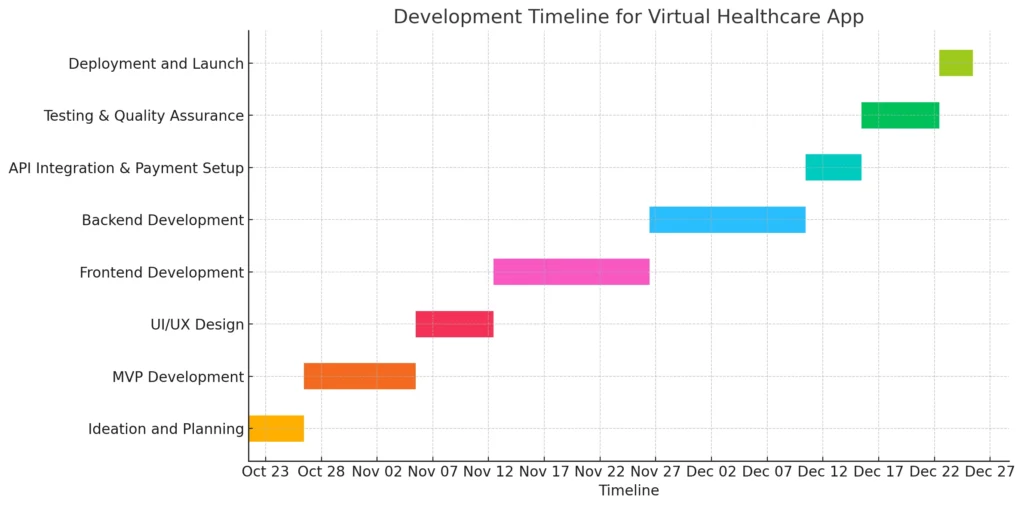
Building a virtual healthcare app involves multiple steps, from conceptualization to launch. A well-organized development process ensures the app is user-friendly, secure, and scalable. Here’s a step-by-step breakdown of the development workflow for creating an app like Zocdoc.
Step-by-Step Workflow
- Ideation and Planning
- Start by defining the core features and target audience.
- Conduct market research to identify competitors and gaps you can fill with your app.
- MVP (Minimum Viable Product) Development
- Build an MVP with only the most essential features (like doctor search, booking, and telemedicine) to gather early feedback.
- Use feedback from beta testers to refine the product before the full-scale launch.
- UI/UX-Design und Prototyping
- Create wireframes and prototypes to visualize the app’s design and flow.
- Ensure the UI is accessible and intuitive for a better user experience.
- Frontend and Backend Development
- Develop the frontend using frameworks like React Native or Flutter for a cross-platform experience.
- Build a robust backend mit Node.js or Django to handle data and manage services efficiently.
- API Integration and Payment Setup
- Integrieren APIs von Drittanbietern (like Zoom for video calls, Stripe for payments).
- Ensure HIPAA and GDPR compliance during data exchange.
- Prüfung und Qualitätssicherung
- Conduct thorough testing to identify and fix bugs and performance issues.
- Include Benutzerakzeptanztests (UAT) to ensure the app meets user expectations.
- Deployment and Launch
- Deploy the app on App Store, Google Play, and the web platform.
- Ensure a smooth rollout with marketing efforts aligned for launch day.
This structured approach ensures that your app launches on time, with all essential features in place, and is well-positioned to scale based on user feedback.
Cost Estimation and Timeframe
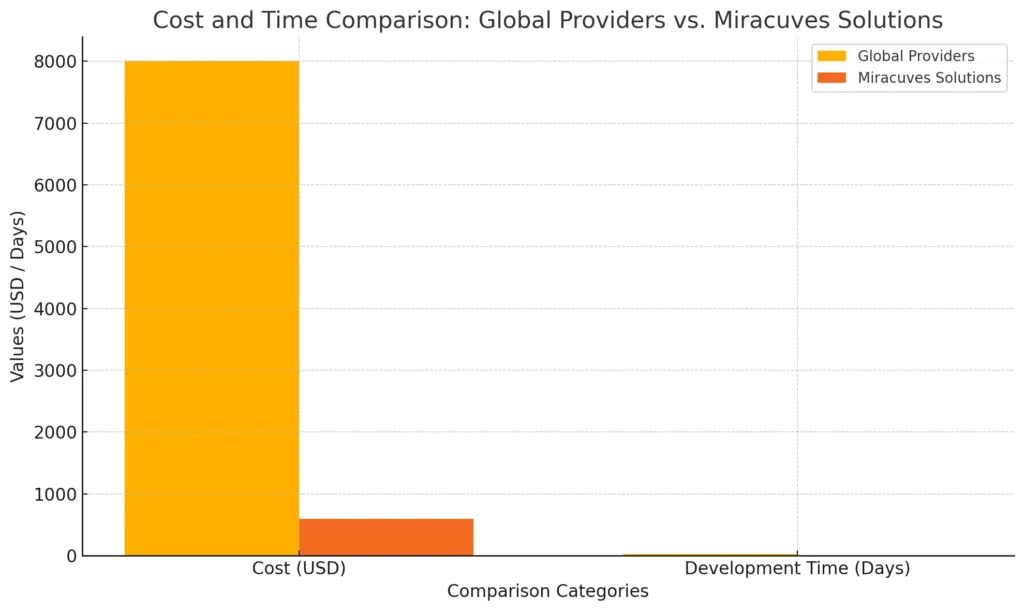
Developing a virtual healthcare app like Zocdoc requires careful budgeting to ensure that the project stays cost-effective. Globally, building a feature-rich app can cost around $6,000 to $10,000, and the development process can take up to one month or more. However, with Miracuves-Lösungen, you get a significant advantage:
- Cost: Just $600, which is 10% of the global cost.
- Zeitrahmen: 1 day, compared to the industry average of 30 days.
Why Such a Big Difference?
- Ready-Made Solutions: Miracuves Solutions uses pre-designed frameworks, cutting down the need for coding from scratch.
- Streamlined Workflow: Advanced tools and optimized processes accelerate development.
- Scalable Technology: Apps are built with scalability in mind, so features can be easily added without major redevelopment.
Global vs. Miracuves Solutions: Cost and Time Comparison
| Aspekt | Global Market | Miracuves-Lösungen |
|---|---|---|
| Kosten | $6,000 – $10,000 | $600 |
| Entwicklungszeit | 1 Month | 1 Day |
| Anpassungsoptionen | Limited without extra cost | Fully customizable solutions |
| Maintenance Cost | Additional charges | Included in package |
Investing in Miracuves-Lösungen means saving both time and money, allowing you to launch your app faster and start capturing the market before competitors.
Lesen Sie auch: - Telemedicine App Development Guide
Warum sollten Sie bei Ihrem nächsten Projekt auf die Lösungen von Miracuves vertrauen?
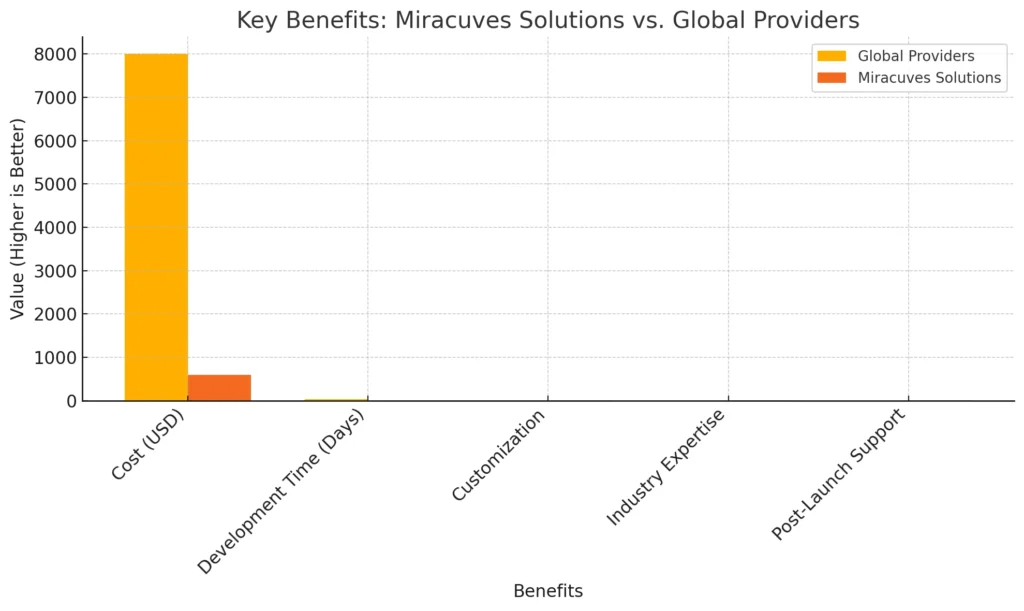
Choosing the right development partner can make or break your app’s success. Miracuves-Lösungen stands out as a leader in the app development space by offering affordable, high-quality, and lightning-fast solutions that help you stay ahead of the competition. Here’s why you should trust Miracuves Solutions for your next virtual healthcare app:
1. Cost-Effective Development
With Miracuves Solutions, you get a complete app for just 10% of the global development cost. This means $600 instead of spending $6,000 or more elsewhere, without compromising on quality.
2. Faster Delivery Time
Miracuves Solutions delivers fully functional apps in 1 day, while competitors may take weeks or even months. This ensures you capture market demand early and avoid delays.
3. Ready-Made and Customizable Solutions
Miracuves Solutions offers ready-made app designs that are customizable to suit your specific needs. You can add features or modify the design effortlessly, ensuring your app is unique.
4. Proven Expertise in the Healthcare Industry
Mit einem portfolio of successful projects, Miracuves Solutions has deep expertise in building healthcare and scheduling apps. Their experience ensures your app complies with industry standards and best practices.
5. Post-Launch Support and Maintenance
Beyond development, Miracuves Solutions offers reliable post-launch support, ensuring your app runs smoothly and stays updated with the latest features and security measures.
Choosing Miracuves Solutions isn’t just a smart business decision—it’s a strategy to gain a competitive edge in the rapidly growing healthcare app market.
Monetarisierungsstrategien
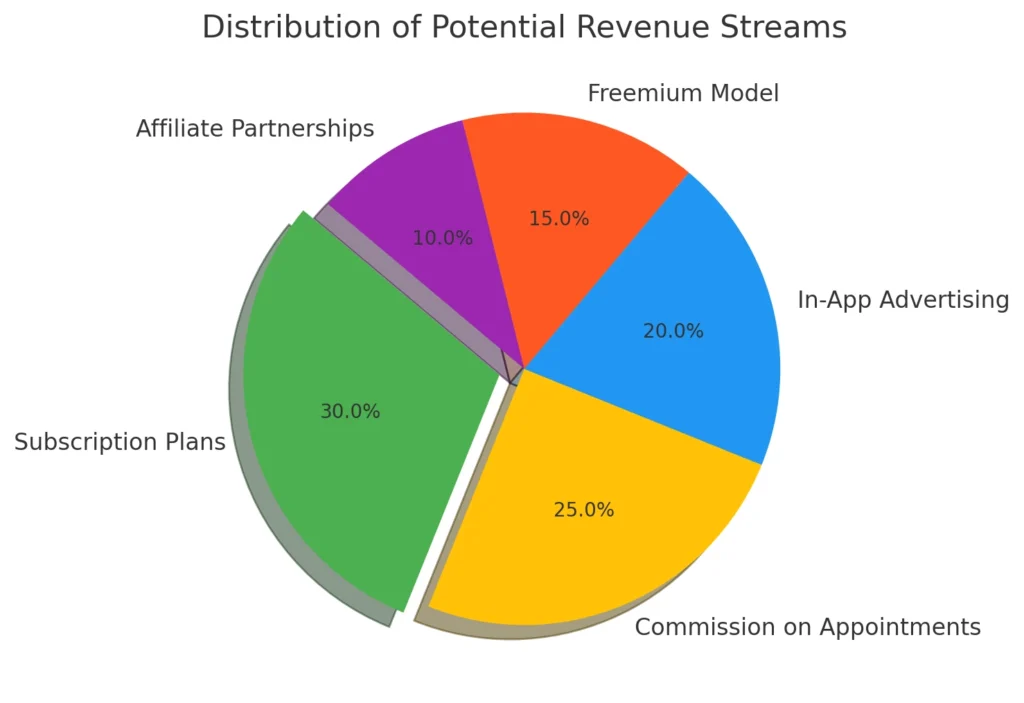
A virtual healthcare app like Zocdoc offers multiple ways to generate revenue while providing valuable services to patients and healthcare providers. Choosing the right monetization strategy is crucial for ensuring long-term profitability and sustainability. Here are the most effective strategies for monetizing your app:
1. Subscription Plans
Offer monthly or annual subscription packages to both patients and healthcare providers.
- Patients: Access to unlimited teleconsultations or priority bookings.
- Doctors and Clinics: Enhanced visibility on the platform and access to patient analytics.
2. Commission on Appointments
Charge healthcare providers a commission for every successful booking made through the app. This pay-per-use model ensures that providers only pay when they benefit from the platform.
3. In-App Advertising
Integrieren health-related ads from pharmaceutical companies, diagnostic labs, or insurance providers. Ensure that the ads are relevant and non-intrusive to maintain a smooth user experience.
4. Freemium Model
Offer essential features like basic consultations for free, while advanced services (e.g., consultations with specialists or video calls) are part of a paid upgrade.
5. Affiliate Partnerships
Partner von pharmacies or insurance providers to earn commissions on every referred service, such as prescription purchases or health insurance plans.
By employing a combination of these monetization strategies, your app can generate sustainable revenue streams while offering value to both patients and providers.
Launching and Marketing the App
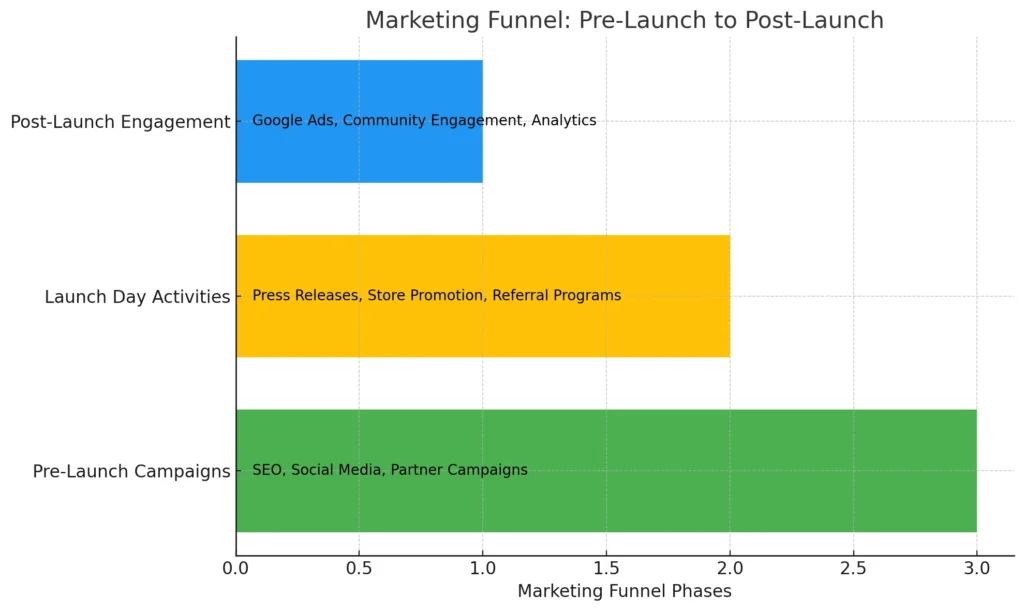
The launch of your virtual healthcare app is a critical phase that requires careful planning to attract users and gain traction in the market. An effective Marketing-Strategie ensures that both healthcare providers and patients discover your app and engage with it from day one. Here’s a step-by-step approach to launching and marketing your app successfully:
1. Pre-Launch Strategy
- SEO and ASO (App Store Optimization): Ensure that your app ranks high on Google and app stores by optimizing keywords related to healthcare and appointments.
- Influencer and Partner Campaigns: Collaborate with healthcare influencers and partner clinics to build buzz around the launch.
- Email and Social Media Campaigns: Tease your app with pre-launch campaigns on Instagram, Twitter, and through newsletters.
2. Launch Day Strategy
- Press Releases and Blog Posts: Announce your app launch through press releases and blog posts on healthcare platforms and forums.
- App Store and Play Store Promotion: Highlight your app’s key features and unique selling points with screenshots and engaging descriptions.
- Empfehlungsprogramme: Encourage users to invite friends and family by offering incentives such as discounts or free consultations.
3. Post-Launch Marketing
- Google Ads and Social Media Ads: Run targeted ads to attract both patients and healthcare providers.
- Community Engagement: Participate in healthcare forums and Q&A platforms like Quora and Reddit to engage with potential users.
- App Analytics and Feedback Loop: Use analytics tools to monitor downloads, user engagement, and feedback, refining the app over time to improve user experience.
Legal and Regulatory Considerations
When building a virtual healthcare app, legal compliance Und data privacy are crucial to gain user trust and avoid penalties. Since healthcare involves handling sensitive patient information, your app must adhere to international laws and local regulations to ensure data security and operational transparency. Below are the key legal and regulatory requirements you need to address:
1. HIPAA and GDPR Compliance
- HIPAA (Health Insurance Portability and Accountability Act) applies if your app operates in the U.S., ensuring the protection of patient health information (PHI).
- DSGVO (Datenschutz-Grundverordnung) applies to apps serving users in the European Union, regulating how personal data is collected, processed, and stored.
For apps serving users in Europe, compliance with the GDPR framework is essential to manage user data responsibly.
2. Data Encryption and Secure Communication
- Verwenden Ende-zu-Ende-Verschlüsselung for all communication within the app, such as chat, video consultations, and payment transactions.
- Ensure that secure APIs are used to transfer sensitive data between your app and third-party services.
3. Medical Licenses and Provider Verification
- Verify that all healthcare providers on your platform hold valid medical licenses and meet local healthcare standards.
- Implementieren Sie eine credentialing process to ensure that the doctors listed on your app are qualified and authorized to offer consultations.
4. User Consent and Terms of Service
- Include a consent form for telemedicine consultations to ensure that patients understand the risks and limitations of virtual healthcare.
- Provide clear Servicebedingungen Und Datenschutzrichtlinien to inform users about their rights, data handling practices, and app usage terms.
5. Regional Regulations for Telemedicine
- Different countries and states have varying laws governing telemedicine. Make sure your app complies with the regulations in the regions you operate, especially for prescriptions and remote consultations.
By addressing these legal and regulatory considerations from the start, you can build trust with users, avoid legal complications, and create a safe space for virtual healthcare services.
Future Growth and Trends
The future of virtual healthcare apps looks bright, with continuous advancements in technology and shifting consumer behavior driving growth. Patients are increasingly seeking convenient, remote healthcare services, while providers look for efficient ways to manage appointments and consultations. Here are the key trends and opportunities that will shape the future of healthcare apps:
1. Integration von KI und maschinellem Lernen
- Apps are leveraging AI to provide personalized health recommendations and match patients with the right specialists.
- Machine learning helps in Prädiktive Analytik, such as forecasting patient needs or identifying high-risk cases early.
2. Internet of Things (IoT) Integration
- Die Integration von wearable devices (like smartwatches and fitness trackers) allows healthcare providers to monitor patient vitals remotely.
- IoT will enable real-time health monitoring, improving chronic disease management and preventive care.
3. Expansion into Mental Health and Wellness
- More apps are offering mental health support, such as therapy sessions and mindfulness tools, as demand for mental well-being services grows.
- The trend towards holistic healthcare combines physical and mental health services in one platform.
4. Blockchain for Secure Data Handling
- Blockchain technology is being used to safeguard patient records by ensuring that medical data is tamper-proof and only accessible to authorized parties.
5. Growth in Emerging Markets
- Virtual healthcare apps are expanding into emerging markets, where access to healthcare services is limited, creating opportunities for growth.
- Governments and organizations are increasingly investing in Telemedizin-Plattformen to provide healthcare in rural areas.
These trends indicate that the demand for virtual healthcare solutions will continue to grow, offering exciting opportunities for innovation and expansion.
Die Integration von telemedicine is transforming healthcare delivery. For more insights and resources, visit the American Telemedicine Association.
Abschluss
Building a virtual healthcare app like Zocdoc is a smart investment in the future of healthcare. With the growing demand for telemedicine, online appointments, and remote healthcare, there has never been a better time to enter the market. Such an app provides convenience for patients, improved efficiency for healthcare providers, and opens new opportunities for revenue growth through innovative services.
By leveraging cutting-edge technologies like AI, IoT, and blockchain, your app can stay ahead of the curve. Moreover, focusing on user-friendly design and compliance with legal standards will build trust among users and encourage adoption.
Partnerschaft mit Miracuves-Lösungen ensures you get a high-quality app at 10% of the global development cost and in just 1 day. This not only saves time and money but also allows you to launch quickly and start serving your customers.
A virtual healthcare app is more than just a tool—it’s a way to empower patients, connect providers, and transform healthcare services. The time to act is now.
FAQs
What is the typical cost of developing a virtual healthcare app?
The average cost of developing a healthcare app globally ranges from $6,000 to $10,000, but with Miracuves-Lösungen, it can be done for just $600.
How fast can my app be developed?
While traditional development can take around 30 days, Miracuves-Lösungen bietet eine 1-day delivery service with ready-made, customizable solutions.
Can I customize my healthcare app according to my needs?
Yes, the solutions provided by Miracuves-Lösungen are fully customizable, allowing you to add features or modify the design to align with your brand and business goals.
Do I need licenses to operate a healthcare app?
Yes, compliance with HIPAA (in the U.S.) Und GDPR (in Europe) is mandatory, along with verifying healthcare providers’ licenses based on local regulations.
How does the app handle payments securely?
The app integrates with sichere Zahlungsgateways like Stripe and PayPal, and all transactions are protected through Ende-zu-Ende-Verschlüsselung to ensure user data safety.

